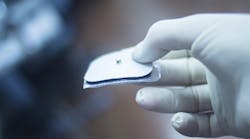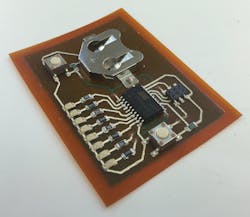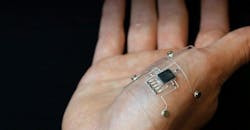In 2002 the movie Minority Report was released, set in a future where police use technology to stop crimes before they happen. While the movie is still science fiction, police are starting to use technology to catch criminals before they get away.
In the past two years, for instance, the data from a Fitbit and social media was used as evidence in a case of murder while in another case, police used a search warrant to obtain a man’s pacemaker data to help convict him of arson.
There might me more cases like this as the use of connected devices continue to grow. In the fourth quarter of 2016, worldwide shipments of wearables reached a record 33.9 million units, according to International Data Corp.
Research in the medical field might cause a rise in wearables in more ways than what you can wear on your wrist or in your ear. Dr.Yonggang Huang, professor of mechanical engineering, civil and environmental engineering, and materials science and engineering at Northwestern University, thinks we will be implanting electronics on the skin and inside the body.
"The human body shape is curvilinear, but the conventional electronics are flat," says Dr Huang. "There is clearly an incompatibility here…” When electronics flex, conductive inks might slightly alter the impedance of the circuit. Changing the impedance of a circuit might cause it to operate inaccurately or at all. Add stretching to this, and the challenges increase. Fortunately, there is a simple solution. Electrical properties are maintained well enough to run components when being flexed or stretched if they are laid out in a zigzag pattern.
To make the entire system stretch, you start with a silicon wafer. This wafer leads to thin silicon ribbons. Then polydimethylsiloxane (PDMS), a silicon-based organic polymer, is strained and bonded to the original thin silicon ribbons. Once the PDMS is removed, the thin ribbons are shown to become wavy. This provides a high semiconductor coverage area, but the wafer stretches less than 20%.
This innovative process gives a little flex and stretch to a material known to be rigid and brittle–silicon.
Larger “waves” can be obtained to increase a circuit’s ability to stretch (>100%). This is accomplished by reducing coverage areas to about 25%.
What Does This Mean?
Having flexible and stretchable electronics means more than just a watch or small computer that can wrap around the body, but also medical devices that can be worn outside or inside the body. Simple monitoring devices could be worn like a temporary tattoo. Dr. Huang even said advanced devices like an EKG machine could be a small sticker-like device that can be worn on the chest for days. Showers and mild sweating aren’t even a problem. (If taking a long bath, or sweating profusely, the device can be removed and stuck back on later without adhesives.)
This electronics device on the skin is being compressed and stretched, but has no adhesive. This stretchable medical device is held on with Van Der Waal forces.
By using Van Der Waals forces, a device could easily be removed and reapplied. This technique means doctors don’t have to worry about compatibility with the patient’s skin, needing to clean old adhesive off, or needing to add more adhesive. If you were to take a shower longer than 20 minutes, swim, or have a rigorous workout, and the device would need to stay on, an adhesive would still be needed.
Where Does 3D Printing Come into Play?
3D printing flexible electronics is not new. BotFactory and Nano Dimension have been 3D printing electronics for years. BotFactory has developed Squink, a 3D printer that uses three heads to print the substrate, conductive ink, and one head to pick and place the electronic components. Nano Dimension has been working on Dragonfly, and they have released a new printer, the Dragonfly2020 Pro. A couple of 3D printing’s strengths are custom, personalize products, which align with both wearables and medical devices. 3D printing is taking wearables to the next level.
A 3D-printed circuit will be popular with wearable technology. Circuits with batteries, and anything necessary, are able to be printed on self-adhering films that can be printed, peeled, and applied directly to the skin.
New technology has proven that it is possible to produce complex electronics that can stretch and flex. Research being done at the Air Force Research Laboratory with Harvard University to develop a new way to “print” stretchable, flexible electronics. The process, dubbed Hybrid 3D printing, uses additive manufacturing to combine soft, conductive inks with a material substrate to wind up with stretchable, wearable electronic devices.
“This is the first time a 3D printer has printed, in a single process, stretchable sensors with integrated microelectronic components,” says Dan Berrigan, a research scientist at the Air Force Research Lab. “Starting from nothing, the printer builds an entire stretchable circuit that blends the mechanical durability of printed components with the robust performance of off-the-shelf electronics.”
One step in hybrid 3D printing is to 3D-print conductive traces of flexible, silver-infused thermoplastic polyurethane into a flexible substrate. Then, a pick-and-place method using empty printer nozzles and a vacuum system sets microcontroller chips and LED lights into that substrate.
In the lab, the researchers used a 3D printer to create conductive traces of flexible, silver-infused thermoplastic polyurethane. A pick-and-place method was then used to install microcontroller chips and LEDs into the flexible substrate, augmented by an empty printer nozzle and vacuum device to create the hybrid circuits.
While new, the potential of flexible and stretchable wearables is spreading. Optomec started 3D printing sensors onto parts such as airplane wings for stress strain analysis in 2015. Then in January 2017 Optomec announced its Aerosol Jet Technology has been deployed by Carnegie Mellon University’s College of Engineering to advance 3D micro-additive manufacturing methods for fully printed conformal sensors, low loss passives, and antennas for on-chip and off-chip electronics. These advancements have significant potential to drive next-generation of manufacturing processes.
Carnegie Mellon’s Advanced Manufacturing and Materials Laboratory (AMML), led by Dr. Rahul Panat, is working on solving fundamental and applied problems in the areas of printed and flexible microelectronics manufacturing and Lithium-ion batteries. These areas are highly relevant to realize devices and systems for wearables and Internet of Things (IoT) applications. Examples include smart contact lenses, wearable electronic clothing, robotic skins, bio-patches etc.
While Fitbits and watches are nice, 3D printing electronics will revolutionize wearable tech in the medical field perhaps without the masses even knowing until they need this innovation. It is possible for this technology to stretch into the entertainment industry. However, currently, much of this technology isn’t designed to handle texts, surf the web, or display apps. For now traditional medical wearables are essentially electronics that can be taped to the body. As new stretchable electronics are developed and pass regulations they might start disrupting the medical industry. However, there is still a lot of work to be done, so traditional medical devices and wearables are safe for now.




